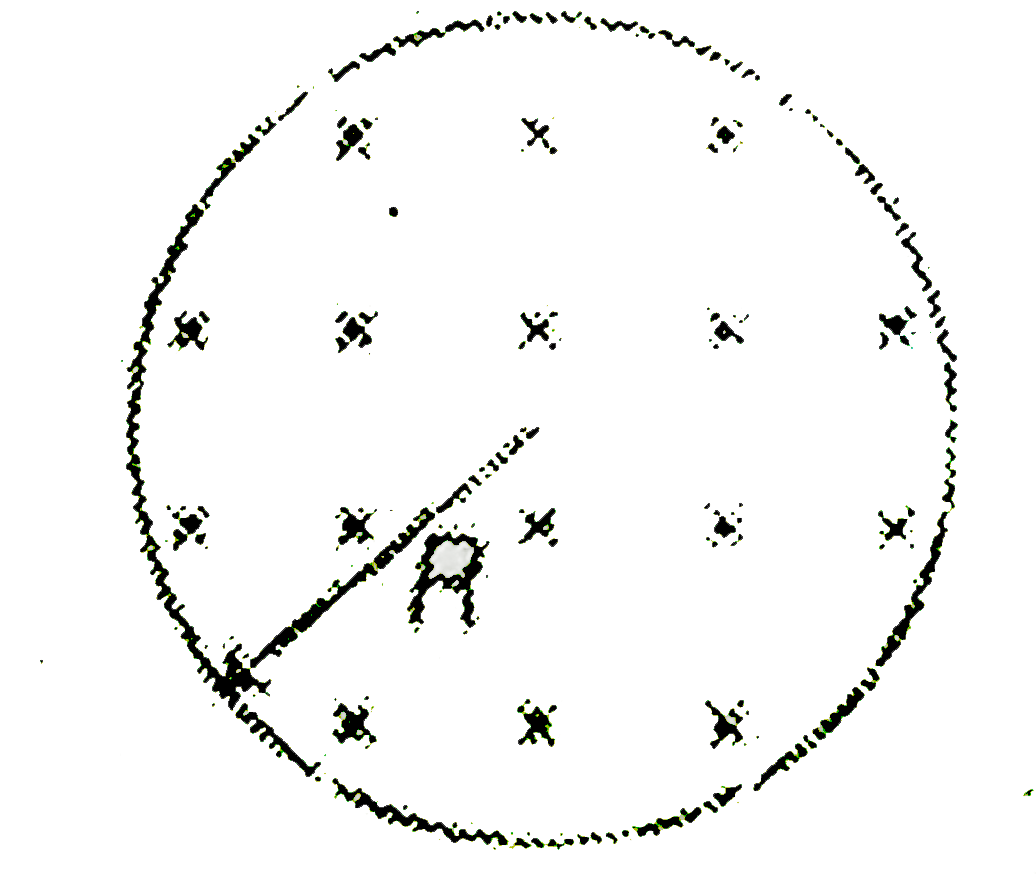A very long solenoid is made out of a wire with n turns per units length. The radius of the cylinder is a and is negligible compared to its length l. The interior of the cylinder is filled with materials such that the linear magnetic permeability varies with the distance r from axis according to μ(r)={μ1=constant , for 0<r<bμ2=constant , for b<r<a}
The self - inductance of the solenoid is
πn2l[μ1b2+μ2b2]
πn2l[μ1+μ2]a2
πn2l[μ1b2+μ2(a2−b2)]
πn2l[μ1b2+(μ1+μ2)a2]
The correct Answer is:C
To find the self-inductance of the solenoid with varying magnetic permeability, we can follow these steps:
Step 1: Understand the Configuration
We have a long solenoid with:
- Length l
- Number of turns per unit length n
- Radius a
- Two regions of magnetic permeability:
- μ1 for 0<r<b
- μ2 for b<r<a
Step 2: Magnetic Field Inside the Solenoid
The magnetic field B inside the solenoid can be expressed as:
B=μH
where H is the magnetic field intensity. For a solenoid, H is given by:
H=nI
Thus, the magnetic field B can be expressed as:
B=μ1nIfor 0<r<b
B=μ2nIfor b<r<a
Step 3: Calculate the Magnetic Flux
The magnetic flux Φ through the solenoid can be calculated by integrating the magnetic field over the cross-sectional area.
1. For the inner region (0 to b):
Φ1=∫b0B⋅dA=∫b0(μ1nI)⋅(πr2)dr
Φ1=μ1nI⋅π∫b0r2dr=μ1nI⋅π(r33)b0=μ1nI⋅π⋅b33
2. For the outer region (b to a):
Φ2=∫abB⋅dA=∫ab(μ2nI)⋅(πr2)dr
Φ2=μ2nI⋅π∫abr2dr=μ2nI⋅π(r33)ab=μ2nI⋅π(a33−b33)
Step 4: Total Magnetic Flux
The total magnetic flux Φ through the solenoid is:
Φ=Φ1+Φ2=μ1nI⋅π⋅b33+μ2nI⋅π(a33−b33)
Step 5: Self-Inductance Calculation
The self-inductance L is given by:
L=NΦI
where N=n⋅l is the total number of turns in the solenoid. Substituting for Φ:
L=nl⋅⎛⎜
⎜⎝μ1nI⋅π⋅b33+μ2nI⋅π(a33−b33)I⎞⎟
⎟⎠
This simplifies to:
L=nl⋅(μ1⋅πb33+μ2(πa33−πb33))
L=nlπ3(μ1b3+μ2(a3−b3))
Final Expression for Self-Inductance
Thus, the self-inductance L of the solenoid is:
L=nlπ3(μ1b3+μ2(a3−b3))
We have a long solenoid with:
- Length l
- Number of turns per unit length n
- Radius a
- Two regions of magnetic permeability:
- μ1 for 0<r<b
- μ2 for b<r<a
The magnetic field B inside the solenoid can be expressed as:
B=μH
where H is the magnetic field intensity. For a solenoid, H is given by:
H=nI
Thus, the magnetic field B can be expressed as:
B=μ1nIfor 0<r<b
B=μ2nIfor b<r<a
The magnetic flux Φ through the solenoid can be calculated by integrating the magnetic field over the cross-sectional area.
Φ1=∫b0B⋅dA=∫b0(μ1nI)⋅(πr2)dr
Φ1=μ1nI⋅π∫b0r2dr=μ1nI⋅π(r33)b0=μ1nI⋅π⋅b33
Φ2=∫abB⋅dA=∫ab(μ2nI)⋅(πr2)dr
Φ2=μ2nI⋅π∫abr2dr=μ2nI⋅π(r33)ab=μ2nI⋅π(a33−b33)
The total magnetic flux Φ through the solenoid is:
Φ=Φ1+Φ2=μ1nI⋅π⋅b33+μ2nI⋅π(a33−b33)
The self-inductance L is given by:
L=NΦI
where N=n⋅l is the total number of turns in the solenoid. Substituting for Φ:
L=nl⋅⎛⎜
⎜⎝μ1nI⋅π⋅b33+μ2nI⋅π(a33−b33)I⎞⎟
⎟⎠
This simplifies to:
L=nl⋅(μ1⋅πb33+μ2(πa33−πb33))
L=nlπ3(μ1b3+μ2(a3−b3))
Thus, the self-inductance L of the solenoid is:
L=nlπ3(μ1b3+μ2(a3−b3))
Similar Questions
Knowledge Check
Which of the following is not correct about relative magnetic permeability (μr)?
AIt is a dimensionless pure ratio.BFor vacuum medium its value is one.CFor ferromagnetic materials of μ>>1DFor paramagnetic materials μr>1
Find the force per unit area on the surface of a long hollow cylinder carrying uniform current I and radius of the cylinder is R.
View SolutionThe relation between length L and radius R of the cylinder , if its moment of inertia about its axis is equal to that about the equatorial axis, will be
View SolutionThe dimension of B22μ0, where B is magnetic field and μ0 is the magnetic permeability of vacuum, is :
View SolutionA cylinder of radius R and length l is placed in a uniform electric field E parallel to the axis of the cylinder. The total flux over the curved surface of the cylinder is
View SolutionA current i is uniformly distributed over the cross section of a long hollow cylinderical wire of inner radius R1 and outer radius R2. Magnetic field B varies with distance r form the axis of the cylinder is
View SolutionA cylindrical space of radius R is filled with a uniform magnetic induction parallel to the axis of the cylinder. If B charges at a constant rate, the graph showin the variation of induced electric field with distance r from the axis of cylinder is

View SolutionA long cylinder of uniform cross section and radius R is carrying a current i along its length and current density is uniform cross section and radius r in the cylinder parallel to its length. The axis of the cylinderical cavity is separated by a distance d from the axis of the cylinder. Find the magnetic field at the axis of cylinder.
View Solution
